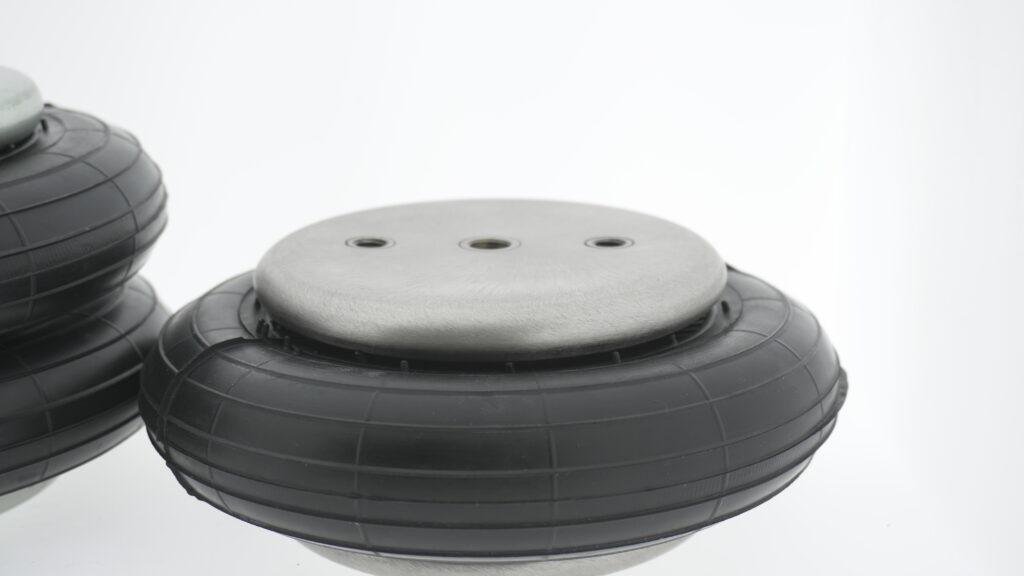
Understanding the Risks of Over-Inflation
Air bellows play a crucial role in industrial applications, ensuring precise force exertion, vibration isolation, and controlled movements. However, over-inflation is a significant hazard that can cause severe structural damage, operational failure, and safety risks. Preventing air bellow over-inflation requires a deep understanding of pressure limitations, material constraints, and preventative mechanisms to maintain system integrity and longevity. Over-inflation can cause rubber failure, leading to structural deformation and reduced load capacity. Standard air bellows operate at a maximum pressure of 8 bar, with high-strength models reaching up to 12 bar. Any deviation beyond these limits can compromise the mechanical integrity and functional lifespan of the system. Operators must ensure that all air supply sources maintain a constant, regulated pressure to avoid accidental over-expansion.
Additionally, variations in temperature and humidity can affect rubber elasticity, increasing the risk of unexpected deformation under load. Poorly maintained bellows may develop weak spots that cannot withstand excess pressure. Ensuring correct installation, regular inspections, and proper storage conditions can help prevent over-inflation failures. Understanding the mechanical behavior of air bellows under different conditions ensures safer, more reliable industrial operations.

Common Causes of Over-Inflation
Over-inflation occurs due to multiple factors, including improper pressure regulation, compressor failures, or operator miscalculations. The most prevalent causes include:
- Exceeding the maximum pressure rating, leading to material fatigue and failure.
- Malfunctioning pressure regulators, allowing excessive airflow into the system.
- Blocked or restricted air outlets, preventing controlled expansion.
- Use of substandard materials, reducing the bellows’ ability to withstand pressure fluctuations.
- External temperature fluctuations, affecting the internal air expansion.
Each air bellow type has a specific burst pressure limit, typically 2 to 3 times the operating pressure. Exceeding this threshold increases the risk of catastrophic failure. Regular pressure monitoring systems should be in place to ensure air pressure does not exceed manufacturer specifications. Understanding these failure points is the first step in implementing a proactive prevention strategy.
Operators should also check for system leaks that may cause pressure instability. Ensuring correct air supply connections and avoiding contamination from oil or moisture will prevent unexpected pressure fluctuations. Properly calibrated digital pressure gauges improve monitoring precision, ensuring safe operating conditions at all times.
Material Considerations for Air Bellow Longevity
High-quality rubber compounds and reinforcement materials significantly impact air bellows’ durability. Tevema offers a range of elastomers designed for different environmental conditions, including:
- Natural Rubber (NR/SBR) – Superior flexibility with high fatigue resistance.
- Nitrile Rubber (NBR) – Excellent oil and fuel resistance.
- Chlorobutyl (CIIR) – Exceptional resistance to chemical exposure.
- EPDM – High resistance to ozone and extreme temperatures.
Air bellows feature reinforced fabric plies between rubber layers, enhancing load capacity and tensile strength. The number of plies varies based on the application, with standard bellows using two plies, while high-performance versions utilize four plies. These reinforcements ensure dimensional stability under high loads and dynamic movements. By selecting the appropriate material, users can minimize risks associated with pressure-related failures.
Additionally, using stainless steel end plates improves corrosion resistance, especially in high-humidity environments. Elastomer compounds should be selected based on chemical exposure levels and temperature variations in the application area. Ensuring proper storage conditions prevents premature degradation of rubber components, extending the air bellow’s operational lifespan.
Best Practices for Pressure Regulation
Maintaining the correct air pressure is crucial for preventing over-expansion. Essential steps include:
- Install pressure relief valves to automatically release excess air beyond safe thresholds.
- Use pressure regulators to maintain consistent air pressure levels.
- Monitor air supply sources to detect pressure fluctuations early.
- Incorporate digital pressure sensors for real-time monitoring and control.
- Implement safety shut-off mechanisms to prevent accidental over-inflation.
Standard air bellows should operate within recommended working pressure limits, which vary by size and design. For example, a 10-inch bellow supports pressures up to 8 bar, while larger models can sustain higher pressures when reinforced with steel bead plates. Regulating pressure ensures operational efficiency while protecting air bellows from damage.
Operators should verify system compatibility before installing new air bellows. Using incorrect hose fittings or adapters can introduce pressure inconsistencies, leading to potential failures. Routine calibration of pressure regulators prevents unexpected fluctuations, ensuring stable and safe performance.
Proper Installation and Maintenance Procedures
Correct installation is vital to ensuring air bellows operate within safe pressure limits. Guidelines include:
- Verify mounting and connection integrity to prevent pressure leaks.
- Use recommended torque settings for fasteners and securing mechanisms.
- Avoid sharp edges and misalignments, which may lead to localized stress points.
- Perform regular inspections to identify signs of material wear or deformation.
Bolted connections should be tightened to manufacturer specifications, ensuring even load distribution. The metallic end closures must be free from corrosion or structural defects that could weaken the air bellow’s attachment points. Routine maintenance involves checking for leaks, cracks, or irregularities that may indicate impending failures. Operators should replace aged or compromised air bellows to maintain optimal system performance.
Additionally, preventative lubrication of metallic contact points reduces abrasion damage, extending service life. Implementing a structured maintenance log allows early detection of wear issues, preventing sudden system failures.
Preventing air bellow over-inflation accidents requires a combination of proper material selection, pressure regulation, installation precision, and environmental awareness. Implementing automated monitoring systems and adhering to strict maintenance schedules will help protect both equipment and personnel from potential failures. Tevema remains committed to providing high-quality air bellows, ensuring safe, efficient, and durable industrial applications.
